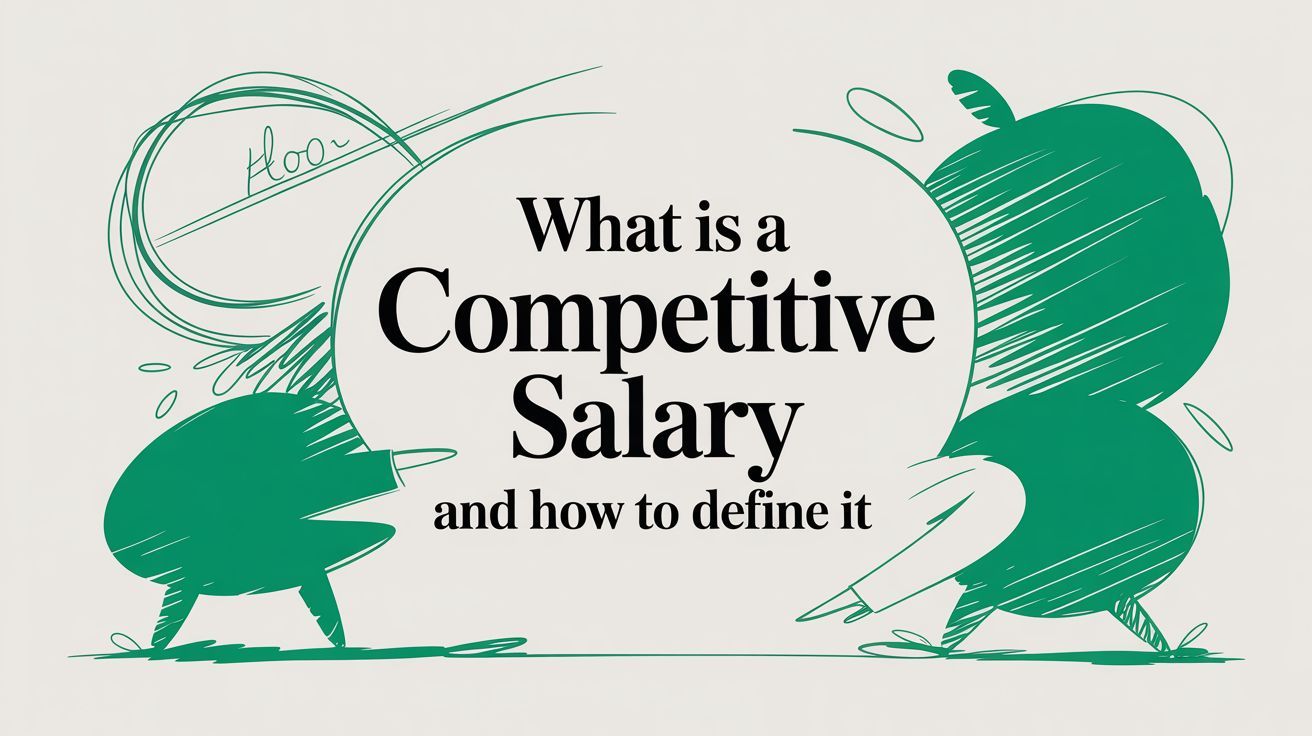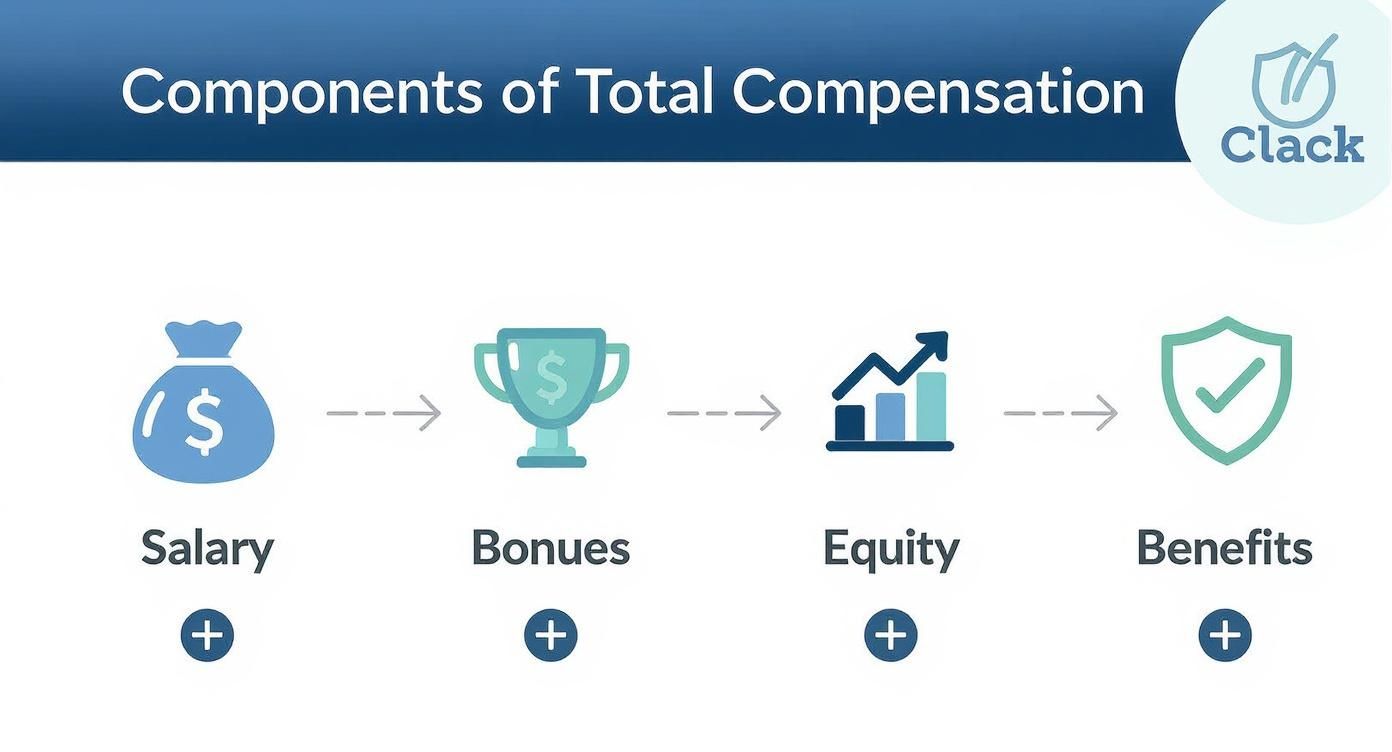What Is a Competitive Salary and How to Define It

What we talk about when we talk about a "competitive salary" has moved far beyond a single number on a paycheck. Think of it as a comprehensive offer designed to not just attract but keep the best people. It’s a strategic package that signals a company is serious about investing in its team, stacking up favorably against—or even beating—what other companies are offering for similar roles.
Understanding a Competitive Salary in Today's Market

Defining what’s truly "competitive" can feel like trying to hit a moving target. It’s not a static figure; it’s shaped by constantly shifting forces like skill demand, the broader economy, and even a company's own financial stability.
Imagine a top sports team trying to sign a star athlete. The final contract is huge, of course, but the player is also looking at the quality of the coaching staff, the state-of-the-art training facilities, and the real shot at winning a championship. A competitive salary works the same way—it’s the total value proposition, not just the base pay.
Getting this right is the critical first step for everyone involved. For companies, it means landing the talent they need to grow without blowing their budget. For professionals, it’s about understanding their market value and confidently securing the compensation they’ve earned.
The Core Factors in Play
To figure out if a salary is actually competitive, you have to look at how several key variables interact. These are the puzzle pieces that create the full picture.
This table breaks down the main elements that go into determining a competitive compensation package.
Key Factors That Define a Competitive Salary
| Factor | Why It Matters | Example |
|---|---|---|
| Industry & Niche | Different industries have vastly different revenue models and talent demands. | A marketing role at a high-growth tech company will almost always pay more than an equivalent role at a non-profit. |
| Geographic Location | Cost of living and the concentration of talent in a specific area directly impact salary expectations. | A $120,000 salary in San Francisco feels very different from $120,000 in Omaha, Nebraska. |
| Company Size & Stage | A company's resources and growth phase dictate its compensation strategy. | A large, publicly-traded corporation might offer higher base pay, while an early-stage startup may offer a lower base but include significant stock options. |
| Skills & Experience | Niche expertise and a proven track record are high-value assets that command premium pay. | A candidate with deep experience in AI-powered marketing analytics will earn far more than a generalist marketer. |
Ultimately, a salary's competitiveness is defined by its context—it doesn't exist in a vacuum.
Why Context Is Everything
A competitive salary is completely relative. Its definition can shift with economic tides and industry trends. For example, forecasts for 2026 suggest that salary increases in major economies like the U.S., Canada, and the UK will be fairly conservative, a sign that companies are being cautious. In this climate, a "competitive" offer might simply be one that delivers an annual raise that keeps you slightly ahead of inflation.
A truly competitive salary is one that is not only aligned with the market but is also part of a transparent and equitable pay structure within the organization. This builds trust and long-term employee loyalty.
At the end of the day, figuring out what is a competitive salary means looking at the entire ecosystem of compensation. This big-picture view is more important than ever, especially as the conversation around pay transparency continues to gain momentum.
Looking Beyond the Paycheck to Total Compensation
It’s easy to get fixated on a high base salary—it feels like the headline number, the big win. But that number rarely tells the whole story. Zeroing in on base pay alone can be a mistake if the rest of the offer is empty. To really know if an offer is competitive, you have to look at the entire total compensation package.
Think of it like buying a car. The sticker price is just the starting point. You wouldn't buy it without asking about the warranty, the fuel efficiency, or the maintenance costs, right? The same logic applies here. Base salary is the sticker price, but the other components are what determine the true value you get over the long haul.
The Building Blocks of Your Financial Package
Each piece of a compensation package adds value in a different way, contributing to your financial stability and overall happiness at work. Let's break down the key components you'll see.
Base Salary: This is your reliable, predictable income. It’s the money you can count on hitting your bank account every payday to cover your mortgage, groceries, and everything in between.
Performance Bonuses: Think of these as a reward for a job well done. Bonuses are tied to your success—whether it's your individual achievements, your team hitting its targets, or the company having a great year.
Equity and Stock Options: This is where you get a real stake in the game. Equity gives you ownership in the company, meaning your personal success is directly tied to the company's growth. It’s a long-term play that can lead to a significant payoff down the road.
Benefits: This is the stuff that provides real financial security. We're talking about health, dental, and vision insurance, but also retirement plans (like a 401(k) with a company match), paid time off, and disability coverage. These are the safety nets that protect you and your family.
Why a Lower Salary Can Be the Smarter Choice
It sounds backward, but sometimes the offer with the lower base salary is actually the better deal. The real value is often buried in the benefits and other perks that don't show up on your paycheck.
Let’s say you’re a marketing manager with two competing offers.
Offer A: A $110,000 base salary. Sounds great, but it comes with a high-deductible health plan that costs you $500 out of pocket each month and a 401(k) with no company match.
Offer B: A $100,000 base salary. The company covers 100% of your health insurance premiums (saving you $6,000 a year) and offers a 6% 401(k) match (that’s another $6,000 of free money).
On paper, Offer A looks like the winner. But when you do the math, Offer B puts an extra $12,000 back into your pocket every year through benefits alone. That makes it the far more competitive package.
This is exactly why you have to look at the whole picture. A killer benefits plan can save you thousands in out-of-pocket costs and help you build wealth faster, easily making up for a slightly lower salary. Don’t forget to factor in other perks, too. Generous PTO, a budget for professional development, or flexible work options add a ton of value to your life, even if they don't have a specific dollar amount attached.
How to Accurately Benchmark Any Salary
Trying to guess your own worth or figure out what to offer a candidate is a recipe for disaster. If you want to land on a truly competitive salary, you have to stop guessing and start benchmarking. It’s a straightforward process of digging into real-world data to figure out an accurate, defensible salary range for a specific role.
Think of it like getting a home appraised. The appraiser doesn't just pull a number out of thin air. They look at recent, comparable home sales in the neighborhood, factoring in everything from square footage to the age of the roof. Salary benchmarking is the exact same idea, just for compensation. It makes sure you’re comparing apples to apples.
Taking this approach is absolutely critical. Why? Because relying on broad, national averages is one of the biggest—and most common—mistakes people make.
Relying on a generic "average salary" for a role is like trying to navigate a city with a map of the entire country. It's technically accurate on a macro level, but completely useless for finding your specific destination. You need granular, localized data to make informed decisions.
Choosing Your Data Sources
To get a truly clear picture of the market, the best strategy is to triangulate data from a few different reliable sources. Each one offers a unique angle, and blending them together gives you a much more solid result.
Here are the most common places you’ll want to look:
- Industry-Specific Surveys: These are gold. Usually published by professional groups or specialized firms, they offer super-relevant data because it’s tailored to a specific field, like marketing.
- Government Labor Statistics: Agencies like the U.S. Bureau of Labor Statistics (BLS) have mountains of compensation data. It’s incredibly comprehensive, but the downside is that it can lag behind fast-moving market trends.
- Validated Online Tools: Platforms like SalaryGuide offer real-time, aggregated data that's often verified by actual users. These tools are fantastic for seeing what’s happening in the market right now and can be filtered by very specific criteria. You can explore a ton of marketing-specific compensation data by checking out our updated salary benchmarks.
This infographic helps visualize all the pieces that go into total compensation, a concept that’s essential for good benchmarking.

As you can see, a competitive package is so much more than just the base salary figure—it's the sum of all its parts.
Comparing Your Benchmarking Options
Not all data is created equal, and it's important to know the pros and cons of each source so you can weigh the information properly.
Here’s a quick breakdown to help you choose the right resources for your needs.
Comparison of Salary Benchmarking Resources
| Resource Type | Pros | Cons | Best For |
|---|---|---|---|
| Industry Surveys | Highly specific and relevant to your exact role and field. Often provides detailed breakdowns of total compensation. | Can be expensive to access and may only be updated annually. | Getting a deep, nuanced understanding of compensation trends within a specific niche. |
| Government Data | Comprehensive, reliable, and free to access. Provides a stable, long-term view of compensation. | Data can be several months to a year old, potentially missing rapid market shifts. | Establishing a solid, foundational baseline for a wide variety of common roles. |
| Online Tools | Provides real-time, aggregated data that is often crowd-sourced and up-to-date. Highly filterable by location, experience, etc. | Data quality can vary depending on the platform's verification process. | Quickly checking current market rates and understanding how specific variables impact pay. |
By combining insights from a few of these, you build a much more complete and defensible salary range.
Applying Filters for an Accurate Match
Once you’ve gathered your data, the final and most important step is to apply the right filters. To benchmark accurately, you have to get specific.
Drill down using these key variables:
- Job Title and Level: "Marketing Manager" is way too broad. Are we talking about a senior manager with 10 years of experience or an entry-level manager? Specificity is key.
- Location: A role in New York City will pay significantly more than the same job in a smaller midwestern town. Cost of living and talent competition are huge factors.
- Company Size and Type: A 20-person startup is going to have a very different compensation structure than a Fortune 500 corporation.
- Specialized Skills: If a role requires expertise in a high-demand area like performance marketing or MarTech, that will absolutely command a higher salary.
Just look at the finance sector for a clear example of how granular this gets. The 2025 Global ETF Salary Survey found that while average total compensation can hit $339,000, bonuses can make up a whopping 62% of the base salary. That same report shows trading roles averaging $510,000, while senior business leaders can command $1.1 million. It’s proof that the role, seniority, and industry drastically change the definition of "competitive."
By carefully applying these filters, you’ll move from a vague, unhelpful national average to a precise, market-validated salary range you can actually use with confidence.
How Geography and Industry Shape Your Paycheck

If you've ever seen a job posting for your exact role in another city and felt a jolt of sticker shock, you’ve witnessed one of the biggest forces in compensation. It’s a simple truth: where you work and the industry you’re in often matter more than your individual skills.
Think of a job title as just a label. The real story—and the real value—is in the context surrounding it. These external market forces create wildly different definitions of a "competitive salary," even for people doing the exact same work.
Location, Location, Compensation
Geography is arguably the single biggest lever on pay. A salary that affords a fantastic lifestyle in one city might barely cover rent in another. This all boils down to the cost of living—everything from housing and transportation to taxes and groceries.
Companies in expensive hubs like San Francisco, New York, or London simply have to offer higher salaries to attract talent. They aren't just competing with other companies; they're competing with the local economy itself. A $90,000 salary might feel like a windfall in a smaller Midwestern city but would be a tough sell for a professional role on the coast.
The rise of remote work has thrown a fascinating curveball into this old-school rule. Companies are now figuring out how to handle pay for employees scattered across the country.
- Location-Based Pay: Most companies still tie salary to the employee's local market and cost of living. If you move from San Francisco to Boise, expect your pay to be adjusted downward to match the new location.
- Location-Agnostic Pay: A smaller, often tech-forward group of companies pays the same salary for the same role, no matter where you log in from.
Your physical or digital "workplace" sets the baseline for your salary expectations. A competitive offer is one that acknowledges the financial realities of that location, whether it's the high cost of a major city or the national market rate for a remote role.
The Industry Divide
Just as powerful as where you work is what kind of company you work for. The financial health, growth potential, and demand for talent in a specific sector create entirely different pay ceilings. An industry with high profit margins and a fierce war for talent will always pay more than one with tighter budgets.
Let's make this crystal clear with an example. Imagine two "Marketing Manager" roles, both requiring five years of experience.
Scenario 1: The Tech Startup: A Marketing Manager at a venture-backed SaaS company in San Francisco. This industry is flush with cash and desperate for talent to fuel growth. A competitive salary here might be $150,000 plus stock options.
Scenario 2: The Non-Profit: The same Marketing Manager role at a regional non-profit in Kansas City. Here, the budget is funded by donations, and the mission is a huge part of the draw. A competitive salary might be $75,000.
The job title is identical, but the context is everything. The tech salary is driven by market competition and revenue potential, while the non-profit's pay is defined by its funding model. Neither is "wrong"—they just operate in different economic worlds.
Globally, these differences are even more stark. Data on global pay statistics shows dramatic variations, with places like Switzerland leading with an average after-tax monthly pay of $6,142. Across the board, technology and finance continue to command salary premiums that can be double what's offered in sectors like manufacturing or retail, proving that both your passport and your industry play a huge role in your earning potential.
A Practical Playbook for Recruiters and Job Seekers
https://www.youtube.com/embed/q7veOz17r2Y
Knowing the data behind a competitive salary is one thing. Putting it to work in the real world—during interviews and offer stages—is something else entirely. Both recruiters and job seekers need a clear plan to navigate those tricky compensation talks.
Think of this as a playbook for both sides of the table. For recruiters, the goal is to land amazing talent without blowing the budget. For candidates, it's about getting paid what you’re worth. Let's turn that benchmark data into confident, successful outcomes.
Strategies for Recruiters and Hiring Managers
Crafting a compelling offer is about more than just a number. It's a thoughtful, transparent process that shows you value fairness and sets the stage for a great working relationship from day one.
1. Build Data-Backed Salary Bands
First things first: use your market research to create formal salary bands for every role. A salary band is simply a range with a clear minimum, midpoint, and maximum. This simple structure is your best friend for maintaining internal equity and staying competitive.
- Minimum: This is your starting point, usually for someone newer to the role or who just meets the core qualifications.
- Midpoint: This is the sweet spot—the target salary for a fully capable, experienced professional who can hit the ground running.
- Maximum: Reserved for your rockstars. These are the candidates with extensive, hard-to-find skills or a proven track record of exceptional performance.
With these bands in place, your hiring team has a consistent framework to follow, which helps eliminate guesswork and bias.
2. Talk Total Compensation, Early and Often
Don’t save the best parts for last. From your very first conversation with a candidate, start framing the opportunity in terms of total compensation. The base salary is just one piece of the puzzle. Make sure you're highlighting high-value perks like top-tier health insurance, a solid 401(k) match, professional development stipends, and flexible work policies.
When you lead with the full package, you shift the conversation from a single number to the complete value proposition. This helps candidates see the bigger picture and makes your offer far more attractive, even if the base salary isn't the absolute highest they’ll see.
3. Prepare for a Collaborative Negotiation
Salary negotiation shouldn't feel like a battle. It’s more of a final alignment check to make sure everyone is on the same page. If a candidate comes back with a counteroffer supported by good data, hear them out.
If their request fits within your band, great—find a way to make it work. If it's a stretch, be transparent about your constraints. You can then explore other ways to add value, like offering a signing bonus or a little extra PTO.
Strategies for Job Seekers and Candidates
Walking into a salary negotiation can feel nerve-wracking, but being prepared is your secret weapon. With solid research and a clear strategy, you can confidently make your case and land a package that truly reflects your value.
1. Build Your Data-Driven Business Case
Before you even think about throwing out a number, do your homework. Use a few different data sources to pin down a realistic salary range for your specific role, experience, and city. This isn't just about finding a number you like; it’s about building a compelling case for why you deserve it. Get ready to talk about your key accomplishments, measurable results, and the unique skills you bring to the table.
2. Know How to Answer the "Salary Question"
We've all been there. The dreaded "So, what are your salary expectations?" question comes up, often way too early. Handling it smoothly is a critical skill.
Instead of giving one specific number and boxing yourself in, offer a thoughtful, well-researched range. Say it with confidence: "Based on my research for this type of role in the Chicago market and my experience delivering X results, I'm targeting a range of $115,000 to $130,000." This shows you're informed, professional, and flexible.
For a deeper dive, our guide on how to answer salary expectations questions walks through several proven strategies.
3. Negotiate Beyond the Base Salary
What if the company can’t quite meet your base salary expectations? Don't give up just yet. This is the perfect time to get creative and negotiate other valuable parts of the offer.
Consider asking for things like:
- A signing bonus to help bridge the gap in your first year.
- A guaranteed performance bonus tied to your 6-month or 1-year review.
- An increased budget for professional development to attend that conference you've been eyeing.
- A few extra days of paid time off or a more flexible remote work arrangement.
Companies often have more wiggle room with one-time payouts and non-cash perks than they do with base salaries. A little creative thinking can help you build a total package that feels like a huge win.
Frequently Asked Questions
When you're talking about money, a lot of questions come up. Let's tackle some of the most common ones we hear from marketers and the companies trying to hire them.
How Often Should a Company Review Its Salary Benchmarks?
The short answer? At least once a year. Think of it as an annual health check for your compensation strategy. This yearly review keeps your pay scales from drifting out of sync with the broader market.
But for some roles, a year is a lifetime. In fast-paced marketing fields like performance marketing or marketing automation—or for any high-demand role—you can't afford to wait that long. For these critical positions, it's smart to check in on the market data quarterly. This way, you can catch rising salary trends early and make adjustments before your top talent starts looking elsewhere.
What Is the Difference Between a Competitive and a Fair Salary?
This is a really important distinction, and it’s one that trips people up all the time.
A competitive salary is all about the external market. It’s what other companies are paying for a similar role, in a similar industry, in a specific location. It's the going rate, plain and simple.
A fair salary, on the other hand, looks inward. It’s about ensuring that people doing similar work with similar performance and experience within your own company are paid equitably. Fairness removes biases—whether they're based on gender, background, or who's a better negotiator. The best compensation strategies are both competitive and fair.
How Do I Discuss Salary If the Recruiter Does Not Bring It Up?
Timing is everything here. You want to wait until the company has shown real interest, which is usually after the first or second interview. By then, they've invested time in you and see your potential, giving you a much stronger position to talk numbers.
When you're ready, you can bring it up naturally. Try something like, "To make sure we're on the same page, could you share the budgeted salary range for this position?" It's a professional and collaborative way to open the conversation. If they ask for your expectations first, be prepared with your researched range and mention that your final number will depend on the full compensation package.
Can I Negotiate for More Than Just Base Salary?
Absolutely—and you should. If a company can't move on the base salary, that doesn't mean the conversation is over. Shifting the focus to other parts of the compensation package is one of the savviest moves you can make.
Consider asking for things like:
- A one-time signing bonus to sweeten the deal.
- A guaranteed performance bonus for your first year.
- More budget for professional development, like that certification you've been eyeing.
- Extra paid time off or a more flexible work-from-home arrangement.
These elements can easily add thousands of dollars in value and make a huge difference in your overall job satisfaction.
Ready to stop guessing and start knowing what you're worth? At SalaryGuide, we arm marketers with the real-world data and tools to benchmark salaries, discover transparent job opportunities, and negotiate with total confidence. Explore our resources and take control of your career today at https://salaryguide.com.